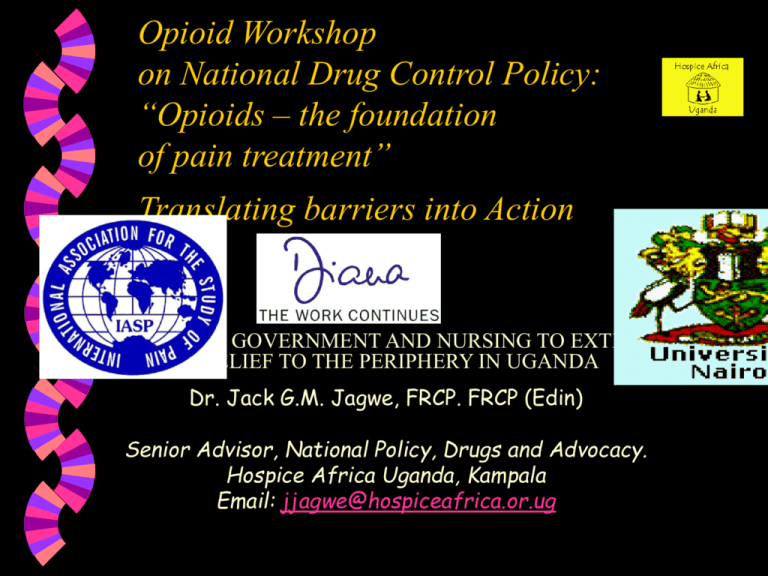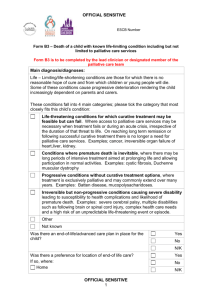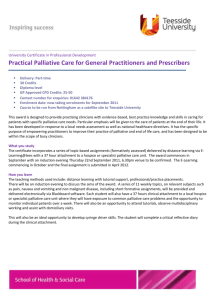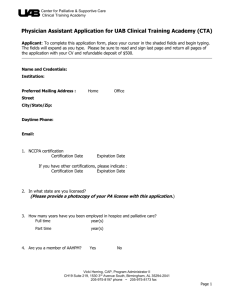Natianal_Control_Drug_Policy-Keynote
advertisement

Opioid Workshop on National Drug Control Policy: “Opioids – the foundation of pain treatment” Translating barriers into Action WORKING WITH GOVERNMENT AND NURSING TO EXTEND PAIN RELIEF TO THE PERIPHERY IN UGANDA Dr. Jack G.M. Jagwe, FRCP. FRCP (Edin) Senior Advisor, National Policy, Drugs and Advocacy. Hospice Africa Uganda, Kampala Email: jjagwe@hospiceafrica.or.ug UGANDA On the equator Temperate climate (20-30’C) Country size: 236,000 sq.kms Slightly smaller than Oregon PEARL OF AFRICA Uganda: Demographic indicators • • • • • • Population – 28 million (2006) UN 52% of population below 15 years 86% live in rural areas 57% never see a health worker Life Expectancy at birth 39 in 1993, 45 yrs 2003 (MoH) Source: Uganda Demographic and Health Survey, 2006 52% OF POPULATION BELOW 15 YEARS Commencing Modern Palliative Medicine – 1967 • Dame Cicely Saunders (RIP 2005) commenced Palliative Care at St Christopher's Hospice in London in 1967. • Previously, through well researched methods of care, pain and symptoms for patients with life-limiting illnesses e.g. cancer and HIV/AIDS she had shown that all can be successfully controlled and Quality of Life improved to the end of life. • In 1987, Palliative Medicine became a specialty under R College of Physicians FIRST STEPS: KAMPALA 1993 HAU 1993 Hospice Africa Uganda commenced with the arrival of Dr. Anne Merriman MBE, FRCP a distinguished physician who started palliative care in Uganda in 1993. The specialty of palliative medicine was introduced for the first time. • She came to address cancer pain but found more suffering arising from HIV/AIDS in 1994. • Adapted cancer pain management to HIV/AIDS pain. • Insisted that Oral Morphine be made available. • Ministry of Health granted her request. • Oral morphine (liquid) formulation was registered in Uganda for the first time. Hospice Africa Uganda, Kampala commenced 1993 Branches: • Mobile Hospice Mbarara: 1998 • Little Hospice Hoima: 1998 The 3 noble objectives of these Hospices: • To provide palliative care services to patients and families. • To carry out education and training in palliative care so that this form of care is available to all patients in need. • To encourage palliative care in other African countries. NOW MAKING UP AFFORDABLE MORPHINE IN HOSPICE Teaching and Research • Recruitment of Nurses & Clinical Officers. • Training them for palliative care. • Work in a defined area: 20km radius from the Hospice • Research at the three above centres. • Strategic exposure of many young doctors and nurses to palliative care and sustaining interest for pain management and symptom control for both Cancer and HIV/AIDS patients. • Lectures/workshops to Health Professionals. • Research/Needs assessment of patients & people suffering with pain in their homes in urban & rural settings. • Collaboration with government and a large Non-governmental organizations network offering Home-Based care & support to HIV/AIDS patients. Approach • Advocacy: Policy makers, Health Officials, leaders & community. • Government moved to incorporate palliative care into the five year Health Support Strategic Programme 2000- 2005. • Palliative care is now part of the Health Care Package of the Essential Clinical Services availed at all Public Health Institutions. • Education: Health Institutions, two medical schools, Health Officials & communities. • Exposure of young doctors to palliative care by lectures to 4th year Medical students and student Nurses since 1994 • International exposure to overseas Medical students who come to do their electives at Hospice Africa Uganda. • Drug Availability: Government through Ministry of Health and the National Drug Regulatory Authority procured powdered morphine for use. • Local manufacture (reconstitution of powdered morphine) keeps the cost very low. • Proper Guidelines worked out by Ministry of Health and stake holders on how to handle Narcotics according to the laws. Progress on Palliative Care in Uganda • Expansion of access to opioids. • Government has authorized specialized Palliative Care Nurses and Clinical Officers to prescribe morphine since March 2004 by revisiting and amending the law on narcotics. • Education, sensitization and familiarization seminars have demystified fears and misconceptions about morphine. • 30 of the 56 districts now access morphine for severe pain. • With a population of 28 million and a doctor:population ratio of 1:18,000 to 1:50,000 in remote areas, someone in remote village can now access oral morphine. Hospice and Palliative Care Organisations in Uganda • Hospice Africa Uganda (1993) • Palliative Care Association of Uganda (PCAU) (1999) • To guide, set standards and ensure drug availability for patient care • Working closely with Uganda PC Country Team based in MoH (2002) UGANDA COUNTRY PALLIATIVE CARE TEAM (2000-2006) Hospice Africa Uganda MoH PCAU Makerere WHO • Country Palliative Care Team in Ministry of Health. Brings together: • Ministry of Health Officials • Hospice Africa Uganda- Palliative Care Workers • WHO Officials • Makerere University Medical School • Mbarara University Medical School • Mildmay International • TASO etc • Kitovu Support Care Organization • PCAU International Collaboration • Hospice Africa Uganda collaborates with Palliative Care Association of S.Africa, Zimbabwe and Kenya. • To spread Palliative care to Sub-Saharan Africa. • Hospice Africa Uganda works with countries and organizations wishing to spread Palliative care in Africa through Advocacy for opioid availability. • Examples: Tanzania, Zambia, Malawi, Botswana, Ethiopia, Ghana, Nigeria, Cameroon, Rwanda, Sierra Leone and Seychelles. African Palliative Care Association (APCA) (2003---5) • Hospice Africa Uganda is Cofounder of APCA • Collaborates with NHPCO, FHSSA, Help the Hospices, WHO and Pain and Policy Study Group of the WHO collaborating Centre, Madison USA etc. • Other African countries Conclusions • Through collaboration with Government. • Through Advocacy based on the 3- WHO Foundation Measures for starting Palliative Care. • Through collaboration with Nursing profession- the backbone of Palliative Care. • It has been possible to take pain relief to the periphery in Uganda. THE END







